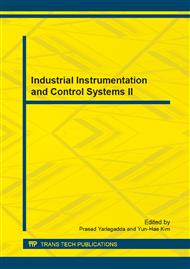[1]
B. Parhami, Computer arithmetic: algorithms and hardware design. Oxford, University Press, (2000).
Google Scholar
[2]
S. Yen, et al., RSA Speedup with Chinese Remainder Theorem Immune against Hardware Fault Cryptanalysis, IEEE Tran. On Computers, vol. 52, pp.461-472, (2003).
DOI: 10.1109/tc.2003.1190587
Google Scholar
[3]
J. Ramirez et al., Fast RNS FPL-based communications re-ceiver design and implementation, " Proceedings 12th Int, l Conf. Filed Programmable Logic, pp.472-481, (2002).
Google Scholar
[4]
R. Conway and J. Nelson, Improved RNS FIR filter architec- tures, IEEE Trans. Circuit Syst. II, pp.26-28, Jan. (2004).
DOI: 10.1109/tcsii.2003.821524
Google Scholar
[5]
A. Afsheh, et. al., An improved reverse converter for moduli set (2n−1, 2n, 2n+1), Intl. Symp. on Communications and Information Technologies, pp.928-933, Oct. (2010).
DOI: 10.22385/jctecs.v3i0.17
Google Scholar
[6]
W. Wang, et. al., A high-speed residue-to-binary converter and a scheme of its VLSI implementation, IEEE Trans. on Circuits and Syst. II, pp.1576-1581, (2000).
DOI: 10.1109/82.899659
Google Scholar
[7]
P. V. A. Mohan, RNS-to-binary converter for a new three-moduli set {2n+1–1, 2n, 2n–1}, IEEE Trans. on Circuits and Syst. II, pp.775-779, (2007).
DOI: 10.1109/82.160172
Google Scholar
[8]
M. Sheu et al., Efficient VLSI design of residue to binary converter for the moduli set {2n, 2n+1−1, 2n−1}, IEICE Trans. INF. and Syst., pp.2058-2060, July, (2008).
DOI: 10.1093/ietisy/e91-d.7.2058
Google Scholar
[9]
M. Hosseinzadeh, et al., An improved reverse converter for the moduli set {2n−1, 2n, 2n+1, 2n+1−1}, IEICE Electronics Express, vol 5. no. 17, pp.672-677, (2008).
DOI: 10.1587/elex.5.672
Google Scholar
[10]
B. Cao et al., An efficient reverse converter for the 4-moduli set {2n - 1, 2n, 2n + 1, 22n +1} based on the new CRT, IEEE Trans. Circuits Syst. I, pp.1296-1303, Oct. (2003).
DOI: 10.1109/isvlsi.2010.105
Google Scholar
[11]
W. Zhang et. al., An efficient design of residue to binary converter for four moduli set {2n-1, 2n+1, 22n-2, 22n+1-3} based on new CRT II, Elsevier J. Inf. Sci., p.264–279, (2008).
DOI: 10.1016/j.ins.2007.05.040
Google Scholar
[12]
A.S. Molahosseini et. al., A new residue to binary converter based on MRC, The 3rd Int. Conf. on ICTTA, pp.1-6, (2008).
Google Scholar
[13]
A. S. Molahosseini et. al., A new design of reverse converter for a three-moduli set, Inte. Symp. on ISPACS, pp.57-60, (2009).
Google Scholar
[14]
Leonel Sousa, Samuel Antao MRC-Based RNS Reverse Converter for the Four-Moduli Sets {2n+1, 2n-1, 2n, 22n+1-1} and {2n+1, 2n-1, 22n, 22n+1-1}, IEEE Trans. Circuits Syst. II, Exp. Briefs, vol. 59, no. 4, pp.244-248, Apr. (2012).
DOI: 10.1109/tcsii.2012.2188456
Google Scholar


